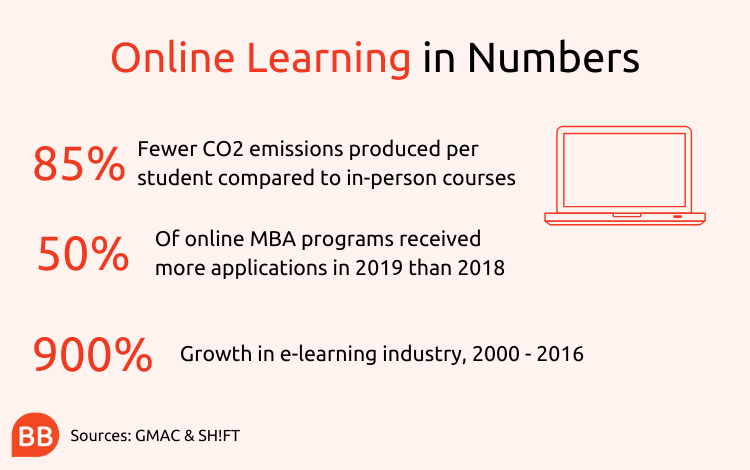The number of business school candidates considering online and flexible MBA programs doubled between 2015 and 2019, according to the Graduate Management Admission Council (GMAC). In the current climate, demand for more flexible learning options looks set to peak.
While purely on-campus learning has traditionally been seen as offering more than online or hybrid alternatives, notes Dr Beth Jones, an associate professor at California University of Pennsylvania (Cal U) who teaches in the school's MBA program, the online or blended classroom has a lot to give that in-person learning simply can't match.
Cal U’s MBA program offers online and blended on-campus options. Starting this fall, students will have even more flexibility through multi-modal learning—the option to attend in-person classes online through live streaming.
Whether blended or fully online, Beth explains, programs that use an online classroom have plenty of advantages for students.
Below, Beth explains four key benefits that blended learning can offer:
1. You will be more engaged
With fewer physical meetings, you might expect to feel distant from your classmates, but Beth argues that an online classroom can actually improve engagement.
Students in a blended program complete some coursework online but also come to campus for real-time sessions.
As a result, they have the convenience of online learning and an opportunity to interact with faculty and peers in person. With the emergence of technologies such as Zoom and Webex, purely online students can build community through having virtual discussions synchronously (at the same time) to complement their independent learning.
For certain learning activities—especially team-based work—this synchronous environment is more efficient, as well as more enjoyable, since real-time interaction makes it easier to share ideas and collaborate.
“Human interaction makes for higher student satisfaction because it’s fun for people to be with people,” Beth explains.
Because online students have to put their ideas in writing before a discussion, she adds, they have already covered the basics when the conversation begins. This leads to deeper, more nuanced discussions and better knowledge retention.
In fact, a study by online learning provider, SH!FT, retention rates for online learning are at least 17% better than classroom learning.
2. You can access the program more easily
It goes without saying that studying through an online, flexible, or blended program offers more adaptability than being tied to a physical classroom.
“Working adults can’t be expected to be in the same place one night a week for 15 weeks,” Beth emphasizes.
With an online program, you can work at your own pace, and apply what you learn to your job straight away, while flexible offerings allow you to keep up with your peers even if you are away from campus.
Passive learning methods, such as lectures, can in fact be more effective when studied online, since recordings and transcripts offer more opportunities to review what you have learned.
With blended and online programs, students can complement these independent sessions with synchronous class discussion—whether virtually or in-person.
The virtual classroom can be more accessible for people with different learning needs, Beth adds.
“Learning online can be a lot less difficult for people who struggle with visually or orally presented information,” she explains. “When we design and create an online space, we are very mindful of that.”

3. You won’t miss out on practical learning experiences
One of the main advantages offered by an MBA is the chance to work on practical projects, and a well-planned online or flexible MBA is equally able to offer these.
Many active learning techniques, such as peer reviews and modeling activities, work efficiently with real-time student interaction, which can be achieved through occasional classroom sessions or virtual conferencing.
In every class that Beth teaches at Cal U, she also makes use of ‘simulations’. These learning experiences mimic a real-world management scenario, giving students the opportunity to practice the skills they have been learning.
In Beth’s most recent simulation, a group of graduate students acted as a virtual company, each taking on a specific role.
“We discussed diversity issues, and each person had a different case to work on based on their role,” she says.
This type of learning experience is crucial, Beth argues.
“If you think about medicine or engineering, we run simulations all the time—why should it be different in management?” she says.
4. You’ll be prepared for the modern workplace
If you have never studied online before, the prospect might be daunting.
For students who have been plunged into the world of remote learning because of coronavirus, Beth acknowledges the transition can be especially tricky.
Along with the technical challenges of time management and working with new communication platforms, the emotional impact of reduced human contact should not be overlooked.
Over the course of her online teaching, though, Beth has found that students quickly adapt, and being able to work both remotely and in-person is crucial for today’s blended workspaces.
Remote working increased by 159% between 2005 and 2017 alone, and companies today need workers who can navigate this landscape.
When you graduate from a MBA program with online elements, like the new flexible MBA at Cal U, you will already have ample experience working in this mixed environment.
As the workplace continues the shift towards increased flexibility and online communication, earning your MBA through an online, blended, or flexible program can help you thrive in this dynamic world.


